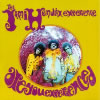
 |
This classic Jimi Hendrix ballad has some wonderful guitar parts. Technically it's not a hard song to play so, it's a great song to learn for the beginner player. Advanced players will also enjoy learning the song, because of the insite it gives us to the creativity of Hendrix. |
I've broken up the song into several pieces as to detail each part. I've also included printable tab sheets so that you can print out the actual tab to the song minus the descriptions and audio.
The transcription is not a complete one of the song. I've omitted some of the verses, but as I will explain to you later you don't really need them. It is a fairly accurate transcription of what Hendrix actually played in the official recorded version found on his debut album Are You Experienced?
The intro riff is built upon 3 power chords. They come from A style barre chords with the notes on the B and high E string omitted. Here are these 3 power chords:
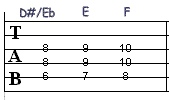
Here is the actual riff. Jimi doubles the 5th of each chord on the low E string and then plays a variation with hammer-ons.

When the riff repeats, a lead fill is added at the end. This fill leads into the first verse.

The riff repeats in different fashion throughout the song. Below you can see how Hendrix makes a minor modification with the fill at the end.

The fills are built off of the F pentatonic major (as is most of the lead lines throughout the song). The intro riff ends on an F chord (which is the key signature). The fill comes from the easily accessable G scale pattern. Below you'll see the F chord using the A style barre chord and then the F pentatonic major scale ascending, which is the same thing as the G scale pattern that Hendrix uses.

You can come up with your own fills using a combination of the F chord using the A style barre chord pattern and the G scale pattern in the key of F (as seen above). The G scale pattern is easy to slip into when playing an A style barre chord:

Here is another example:
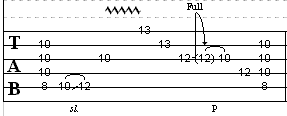
Jimi Hendrix phrases from the chord progression throughout all 4 verses of the song. Here I've transcribed the 1st verse. The other 3 verses follow the same chord progression and uses similar phrases. In other words you only need to learn the first verse and then you will be able to play the other 3 verses.
Now let's take a listen to the entire verse with bass and drums, similar to the actual recording:
Let's break it down:
The letters at the top of the tablature staff indicate the chord in the chord progression that Hendrix is phrasing from. If you wanted you could simply strum these chords to play along with the song. Being the great player we all know and love, Jimi opts to phrase from the chords using the basic scale patterns associated with each chord pattern that he plays.
Below Jimi use E style barre chords to play lines from the C, C#/Bb, and F chords. He uses his thumb to fret the notes on the low E string (the 5th string is omitted). If you want to play the passages you'll want to use your thumb also. This allows greater use of the other fingers to fret notes. He doesn't add to many extra notes here, but the ones that he does come from the E scale pattern.

Below the A style barre chord is used here for the C chord. Over the C#/Bb chord, Jimi plays from this chord's G scale pattern (root on the 6th fret).

The line below uses the open C chord, A style barre chord for the C#/Bb (with a "walk down" from the C chord. The F chord is once again formed with an E style barre chord with the thumb on the 1st fret of the low E string.

Here comes the change. E style barre chords form the G and C#/Bb chords along with voicing from the E scale pattern. Then we reprise the first part of the intro riff.

The change is repeated...
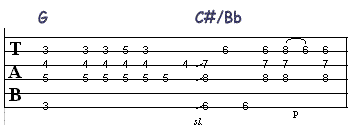
...except at the end the entire intro riff is played with a fill at the end. After the fill you can either go into another verse or the solo.

Before we get onto the actual solo, let's learn what the solo is being played over. The song introduces a new theme for the solo. It contains phrases built from a chord progression of F, D#/Eb, C#/Bb, G#, Ab which is repeated 3 times. Then it changes into a G, C#/Bb, C#/Db, F progression before heads into another verse.





Here I have broken the solo up into 5 different parts. 4 of these 5 parts are almost identical. They're each basically just variations upon the same musical theme. These 4 parts (phrase 1, 2, 3, and the ending line) are built upon the G and E scale patterns in the key of F (F pentatonic major). There is a brief change in the solo and the scale patterns used gets a little more intricate, but more on that in a moment.
Let's break it down. Practice each phrase separately. When you think you've got them all, try it over the music. At first you may want to practice it over the audio example above, or the original recording.
Phrase 1:

Phrase 2:

Phrase 3:

Here's the change. Here he does something that we don't see enough of in rock oriented music. During this brief change Jimi uses a different scales for each chord that he solos over. Over the G chord he plays a variation of the previous theme from the first few phrases except in the key of G (simply moved up 2 frets). The line at the end that's played over the E#/Db chord voicing is from the E#/Db pentatonic minor ( E minor scale pattern). Something tells me that Jimi knew his CAGED scale patterns and the chords that they are associated pretty well.

Ending:
This is simply a reprise of the theme played in the first 3 phrases of the solo except with an alternate ending bringing closure to the solo. After the solo the song heads into a 3rd and 4th verse, then proceeds to the outro.

After the 4th verse the riff from the intro is played repeatedly as such:

A 2nd lead guitar adds these phrases on top.
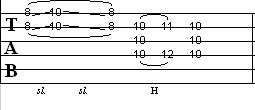


After the 4th verse the riff from the intro is played repeatedly as such:

Here's how it sounds together.